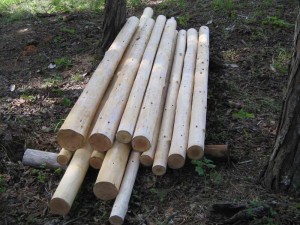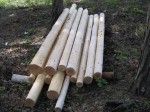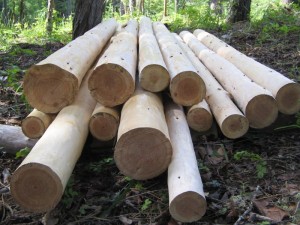 I can produce hand peeled logs or poles of just about any size. I have mostly Douglas fir poles but some ponderosa pine, incense cedar, sugar pine, white fir and grand fir at times. Most of the small logs and poles come from suppressed trees and have small knots or are free of knots. You can get more details and pricing at peeledlogs.com.
I can produce hand peeled logs or poles of just about any size. I have mostly Douglas fir poles but some ponderosa pine, incense cedar, sugar pine, white fir and grand fir at times. Most of the small logs and poles come from suppressed trees and have small knots or are free of knots. You can get more details and pricing at peeledlogs.com.
Peeling the bark off by hand produces a finished log with a smooth natural surface and preserves the natural character of the log. This is unlike most poles that are peeled by mechanical peelers that often leave a splintery surface.
These hand peeled poles and small logs are harvested from dense stands of straight tall conifer trees that are over crowded. The trees are being thinned to allow the remaining trees to be more healthy, grow faster, get larger and more wildfire resistant. The excess trees are made into wood products including hand peeled logs.
The logs are hand peeled in the spring when the bark becomes loose and is easy to peel. This produces a log that is completely free of bark and naturally smooth except for occasional knots, which are trimmed flush to the log. Douglas fir hand peeled poles will check or crack as they dry but this is normal for most logs.
If kept dry, the light colored smooth surface is attractive and is great for indoor use. It can be kept natural or you can apply a finish or paint it. Possible uses include: rustic furniture, railing, pole construction, posts and beams, and more.
Douglas fir logs are known for being stronger than pine and more rot resistant. This makes Douglas fir logs great for structural material. They will last for years outdoors, as long as they are kept off the ground and are able to dry out between rain. But they will eventually deteriorate in wet environments. Douglas fir logs can be used for outdoor garden structures, arbors and many other outdoor uses but don’t expect them to last forever, especially if they are in contact with soil. peeledlogs.com



72 thoughts on “Hand Peeled Logs”